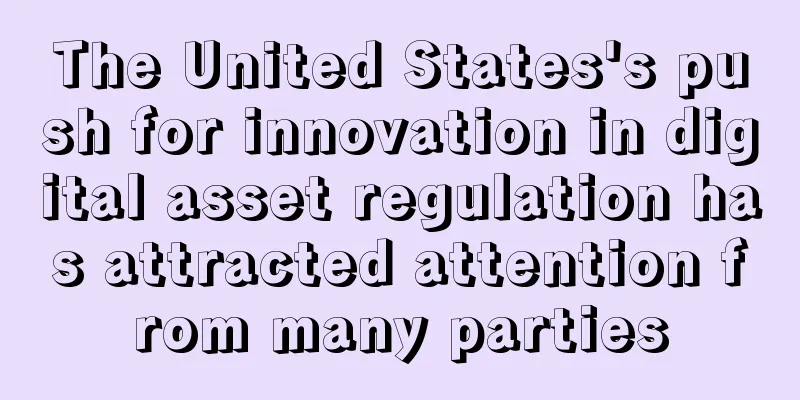The United States's push for innovation in digital asset regulation has attracted attention from many parties

|
Recently, US President Biden signed an executive order titled "Ensuring the Responsible Development of Digital Assets", calling on government agencies such as the Federal Reserve and the Treasury Department to evaluate the benefits and risks of digital assets and explore the development of the US central bank digital currency. The scale of digital assets in the United States has grown rapidly. According to published statistics, in November 2021, the total market value of digital assets issued by non-state-owned enterprises in the United States has reached 3 trillion US dollars, far higher than the approximately 14 billion US dollars in early November 2016. As digital assets are growing explosively, they are also causing more concern among all sectors about potential issues, including data privacy and security, financial stability and systemic risk, financial crime, national security, financial inclusion and fairness, and other issues. Institutions and individuals in the United States, including cryptocurrency exchanges, legislators, and financial practitioners, are looking forward to clearer industry regulatory rules. The executive order emphasizes six key priorities, namely consumer and investor protection, financial stability, illegal finance, the United States’ leadership in the global financial system and economic competitiveness, financial inclusion, and responsible innovation. This shows the importance this order places on risk regulation of digital assets. The executive order clearly states that cybersecurity issues and market failures of major digital asset exchanges and trading platforms have caused billions of dollars in losses to consumers, investors, and businesses. The United States should ensure that security measures are in place and promote the development of digital assets to protect consumers, investors, and businesses, maintain privacy, and prevent arbitrary or illegal surveillance that could lead to human rights violations. The executive order states that, for U.S. and global financial stability, some digital asset trading platforms and service providers are growing rapidly in size and complexity and may not be subject to or comply with specific regulations or oversight, and these institutions need to find regulatory approaches to address risks. The executive order also mentions the need to mitigate the illicit financial and national security risks posed by the misuse of digital assets, such as using digital assets as a means of money laundering, cybercrime, and ransomware. The executive order believes that current and future digital asset systems should have appropriate controls and accountability to promote high standards of transparency, privacy, and security. In response to the above risks, the executive order requires relevant regulatory agencies including the U.S. Office of Science and Technology Policy, the Federal Reserve, the U.S. Federal Trade Commission, the Consumer Financial Protection Bureau, the U.S. Securities and Exchange Commission, and the U.S. Commodity Futures Trading Commission to form multi-party cooperation within different jurisdictions to assess the positive and negative impacts of U.S. digital assets, identify regulatory gaps, and call on regulators to ensure adequate supervision, assess opportunities to mitigate such risks through supervision, and develop a coordinated action plan to guard against any systemic financial risks and other risks brought about by digital assets. While acknowledging the importance of cryptocurrencies and calling for tighter regulation, the executive order also encourages the research and development of central bank digital currencies, highlighting the U.S. government's attempt to reverse its lagging position in the field of legal digital currencies and thereby promote U.S. competitiveness in digital asset technology. Analysts believe that this presidential executive order will not only affect the development of digital assets in the United States, but also affect the decision-making of other countries. Biden hopes to put the United States in a leading position in this industry. Given the United States' hegemonic behavior in the existing world financial system, this will prompt other countries to think more deeply about this and make corresponding decisions. |
<<: Delphi: Music NFT model trends, investment theories and considerations when issuing
>>: Energy giants’ BTC mining potential is rising
Recommend
Grayscale has registered 6 new trust entities, including AAVE, ATOM, DOT and other projects
According to BlockBeats, Grayscale has registered...
Why is it said that people with skewed sun and moon angles will suffer disasters even if they are rich?
Wealth and disaster are never relative, so a pers...
What kind of palm lines can help a woman to be a lucky wife?
Palmistry is related to our fortune, and naturall...
Analysis: After Istanbul upgrade, Ethereum's theoretical maximum TPS is 2048, but a new bottleneck has emerged
According to foreign media news today, iden3, a b...
Over the past week, the amount of ETH destroyed exceeded 72,000, an increase of 38% from the previous week.
Data shows that the current amount of Ethereum de...
Judging from your face whether you will have a boy or a girl
People often ask if it is possible to tell whethe...
CME Futures Volume Hits Record High, How Will This Affect Bitcoin's Spot Price?
Bitcoin’s current market is experiencing a signif...
People with stray hairs on their foreheads are paranoid and like to dwell on trivial matters.
Everyone is an independent individual with his or...
UK ban on crypto derivatives may fail to protect investors
The Financial Conduct Authority (FCA), which regu...
Apple chin woman's face analysis
In physiognomy, the chin is the location of a tre...
Lawyers say: If you want to play with virtual currency, you must know the legal knowledge
Reposted from: Xiao Sa Legal Team Author: Xiao Sa...
What kind of women are popular?
People's personalities are all kinds of stran...
What does it mean if a woman has fox eyes?
What does it mean if a woman has fox eyes? 1. Cha...
Is it good for a woman to have droopy eyes?
What is droopy eye corners? The physiognomy book ...
Innomina G32 product delivery time update
Dear G32 customers, We announced earlier this mon...









